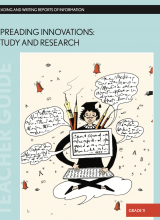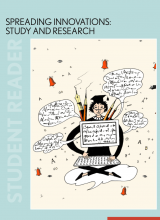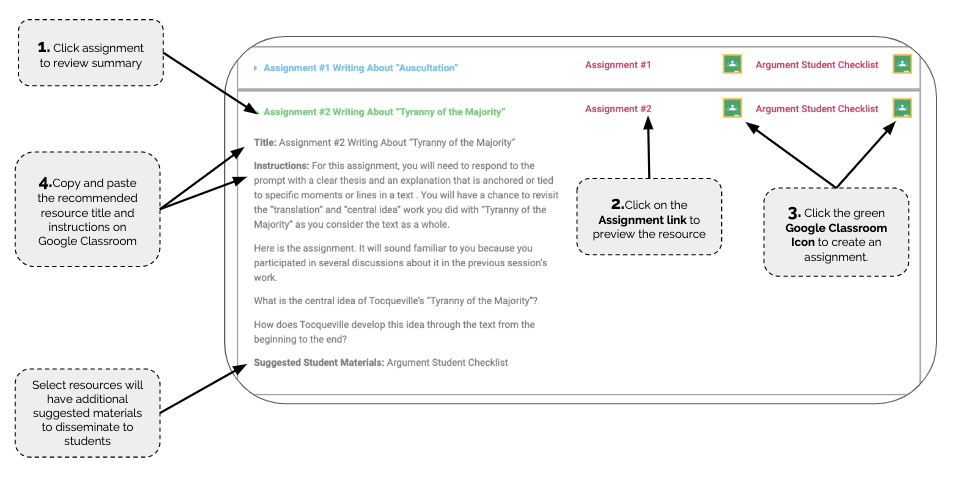Spreading Innovations: Study and Research - Grade 11
The work in this unit begins with a study of “Slow Ideas” by Atul Gawande. In this article, Gawande works from several examples of innovations in the medical field to make a case for what makes innovations spread. The article, which was originally published in The New Yorker, is interesting for both what it says and how it is written.


Table of Contents
Writing Tasks
Title: The First Assignment: Reading Slow Ideas
Teacher Manual Instructions:
Review the assignment with students and explain that the work of this session and half of the next session will be dedicated to providing time for students to complete the steps that are outlined. Let students know that they’ll participate in a whole-class discussion to share their two-column charts in the next session.
Title: The Second Assignment: Studying Gawande’s Examples
Teacher Manual Instructions:
Session 3
Review the contents of the “Sketching the Sequence” task with the class and answer any questions students have about the assignment or the work to be done.
Consider taking time to complete the work with the first one or two sections as a whole class. This will ensure that students can move more smoothly into the remainder of the work in their small groups.
Title: The Third Assignment: Making a Case
Teacher Manual Instructions:
Session 4
Review the assignment with the class, giving students the opportunity to ask questions. Tell students that the “Making a Case” assignment is a group task that they will complete working in trios. Let students know that they will have time in Sessions 5 and 7 to work on their assignment in class. Presentations will begin in Session 8.
Title: The Final Assignment: The Research-Based Report Project
Teacher Manual Instructions:
Session 9
Review the assignment as a class and answer any questions students may have. Consider asking students to take a moment to annotate key language and requirements in the task and then review these annotations together.
Tell students the first part of this work period will be dedicated to brainstorming innovations. They will have the remainder of the session to research many innovations and/or problems.
Title: Sub-Assignment #1: Exploring Innovations
Teacher Manual Instructions:
Session 9
Answer any questions students have about the first sub-assignment. Again, consider asking students to take a moment to annotate key language and requirements in the task and then review these annotations together.
Title: Sub-Assignment #2: Researching Innovations
Teacher Manual Instructions:
Session 11
Title: Sub-Assignment #3: Analyzing Innovations
Teacher Manual Instructions:
Session 12
Title: Sub-Assignment #4: Writing Your Research-Based Paper
Teacher Manual Instructions:
Session 13
Charts for Discussion
Title: Gawande’s Reasons and Evidence for What Makes Innovations Spread
Teacher Manual Instructions:
Session 2
Convene the whole group. Invite pairs to share the information on their two-column chart with the whole group. You might do this by asking pairs to display their chart using a document reader, or you might simply have them talk through their chart.
As students are sharing, record the reasons, evidence, and examples they offer in order to create a “class-version” of the same two-column chart. Title this class chart “Gawande’s Reasons and Evidence for What Makes Innovations Spread.”
As you create this class chart, be sure to record the page and line numbers for both the reasons and the evidence and examples to support the reasons. Post the chart so that it can be referenced easily in the work ahead.
Title: Structure of “Slow Ideas”
Teacher Manual Instructions:
Session 3
To wrap up this work, create a chart with students to map out the organization of “Slow Ideas.” List what Gawande does first, second, third, etc. Label this class chart “Structure of ‘Slow Ideas.’”
Title: Innovations: Problems and Solutions
Teacher Manual Instructions:
Session 4
Convene the whole group. Engage students in a discussion in which they share their lists of innovations and the problems those innovations address. Create a class chart and title it “Innovations: Problems and Solutions.” “Test” the innovations students offer against the definition of innovation that was offered during the focus lesson. Additionally, ask students to identify the innovations as a product, process, idea, social movement, service, technology, or a combination of some or all of these.
Title: Citations
Teacher Manual Instructions:
Session 14
Distribute a style manual to each student in the class and allow a few minutes for them to thumb through the text (or, alternately, direct students to the Purdue OWL website).
Explain to the class that, in addition to providing information on grammar and punctuation, style manuals also supply writers with helpful information related to research-based writing.
Ask the class to turn to the “Brief Contents” section of Hacker’s A Pocket Style Manual and to briefly skim over the items listed under the following sections: “Research,” “MLA Papers,” “APA Papers,” and “Chicago Papers.” On the Purdue OWL website, this is found under “Research and Citation Resources.”
Write on the board the name of the particular citation type students are expected to use in your classroom. Tell students that they should ignore the sections covering other citation types.
Have students take a minute to look over the contents of the citation section they need to learn. Ask them to make a few notes about its contents and its organization.
Afterwards, ask students to share what they found with the class. List their findings on a chart titled “Citations.”
Independent Reading
Title: Book Interview
Instructions:
Display a copy of the “Book Interview” sheet for the class to see and distribute copies to students.
Using one of the books from the classroom library, model for students how to interview a book and how to fill out the sheet. Answer any questions students have about the form and its terminology.
Give students time to interview three books and to enter their findings on the “Book Interview” sheet.
Title: Book Pass
Instructions:
Organize students’ desks into a circle (or, if this is not possible, determine a very clear path for books to pass through the group).
Explain the purpose of a book pass:
A book pass is another way to expose students to the texts available in the classroom library. A book pass requires students to use their book interviewing skills. A book pass is a chance for students to find titles to add to their “Books I’d Like to Read” list.
Display a copy of the “Book Pass” for the class to see and pass out copies to students.
Demonstrate for the class how a person goes about making an entry on the form. Since students will need to write quickly, show how an author can be listed just by last name and first initial, and demonstrate how a student can abbreviate a long title if necessary. What matters is that they have enough information to track down the book again later if they need to.
Give each student one book (or magazine). Tell them it doesn’t matter which text they start with, because they will see all—or at least many of—the books. (Be sure you have one title for each student in the circle.)
Choose a direction for passing.
After students receive a book, they should immediately record the author’s name (if the text is a book) and title on the “Book Pass” form.
Give students one minute to interview each book following the procedure established in the previous session.
At the end of one minute, call “pass.” At this time, students should make an entry in the comments column and pass the book to the next student.
Continue the book pass until each student has interviewed all the books.
Title: Book Recommendation
Instructions:
Distribute copies of the “Book Recommendation” form to students and give them time to craft or begin crafting their first review. Students can choose to write about a book they’ve completed recently or one they remember well from past reading.
Title: Goals for My Reading Life
Instructions:
Display a copy of “Goals for My Reading Life” for the class to see and distribute copies to students.
Use this time to review how to fill out the goals sheet. Be sure to show students how they can use the charts to generate ideas for answers to the “Goals” questions.
Take a moment to stress the value and function of the “Books I’d Like to Read” list. Point out that this list is a tool that serves the same function as a bedside table for some readers: It is a place to store up titles or books that are “next in line.” Remind the class that readers constantly have their eyes open for “next” texts. A “Books I’d Like to Read List” is a way to prevent aimless and unproductive castings around for new reading materials. It’s a planning tool.
Explain that at the beginning of each marking period, each student will fill out a new goals sheet; at at the end of each marking period, students will take a few minutes to review their goals statements and reflect on their efforts to meet them.
Answer any questions students have about the “Goals for My Reading Life” forms.
Give students time to complete the form and set a deadline for submission. You may decide to photocopy these to keep a set for yourself. Return the forms to students during the next session and have them attach the form to a page in their notebook or save it for their student portfolio (see Creating a Student Portfolio).
Title: Reading Log
Teacher Manual Instructions:
Show students how to set up a “Reading Log” in their notebook. They should be sure to enter it in their table of contents. You may decide to distribute sticky notes so that students can flag this page. Use the model on the next page to guide your efforts.
Notice the column titled “Date Completed/# of Pages Read.” This column is a place for students to record, and receive credit for, the reading of texts that did not require a “cover-to-cover” experience. Be sure to point out that reading sections of several texts for specific purposes is not the same as skipping aimlessly from book to book to book. The former often indicates purposefulness and interest; the latter can indicate confusion or disengagement.
After students have set up the reading log—including proper headings, creating the grid, etc.—demonstrate how to make an entry.
Answer any questions students have about the log.
Remind students that the reading log is a tool to be used in conjunction with the “Goals” sheets. Students track their reading in the log and then use the log to evaluate their progress toward their goals.
If you plan to use student portfolios this year, consider introducing them at this time using some version of the information in the section that follows. Review Creating a Student Portfolio in advance to be sure you have thought through some of the important questions for portfolio work.
Unit Resources
Title: The Second Assignment: Studying Gawande’s Examples
Title: The Final Assignment: The Research-Based Report Project
Title: Internet-Based Resources: The Scholarly Article
Title: Library Resources: Searching For, and Within, Books
Title: Sub-Assignment #4: Writing Your Research-Based Paper
Title: Grades 11 and 12 – Interpretive_Argument Rubric
Title: Grades 11 and 12 – Informational_Explanatory Rubric
Title: Scaffolds and Modifications: Descriptions and Use
